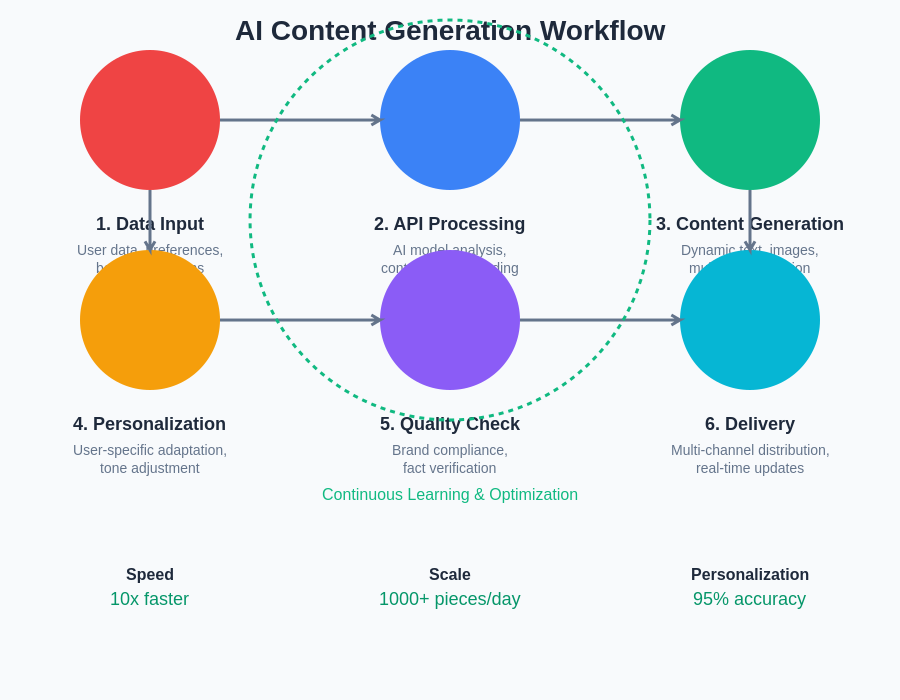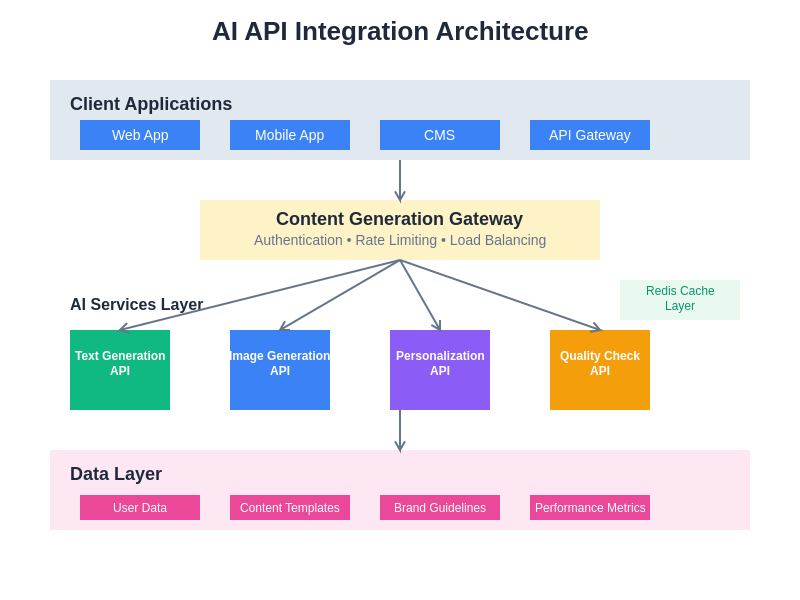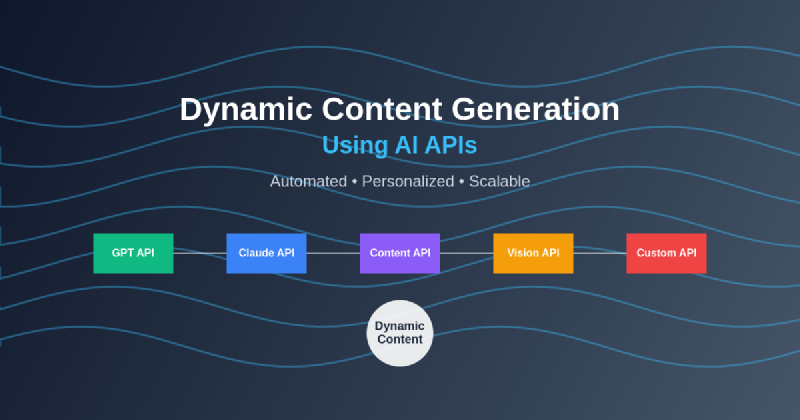The digital landscape has witnessed an unprecedented transformation in content creation and management through the revolutionary capabilities of artificial intelligence APIs. Dynamic content generation using AI APIs represents a paradigm shift from traditional static content approaches to intelligent, adaptive, and personalized content ecosystems that respond to user behavior, preferences, and contextual requirements in real-time. This technological evolution has empowered developers, content creators, and businesses to scale their content operations while maintaining quality, relevance, and engagement at levels previously unattainable through manual processes.
The integration of AI APIs into content generation workflows has fundamentally altered how organizations approach content strategy, enabling them to create vast amounts of high-quality, contextually relevant content that adapts dynamically to user needs and market conditions. Discover the latest AI content trends to understand how cutting-edge technologies are reshaping content creation and distribution across various industries and platforms.
Understanding Dynamic Content Generation
Dynamic content generation represents a sophisticated approach to content creation that leverages artificial intelligence to produce, modify, and optimize content in real-time based on various parameters including user demographics, behavior patterns, preferences, and contextual information. Unlike traditional static content that remains unchanged regardless of who views it or when it is accessed, dynamic AI-generated content adapts continuously to provide personalized experiences that enhance user engagement and satisfaction.
The foundation of dynamic content generation lies in the seamless integration of AI APIs that can process vast amounts of data, understand context and intent, and generate human-like content across multiple formats including text, images, videos, and interactive elements. These APIs serve as intelligent content engines that can analyze user interactions, market trends, and business objectives to create content that not only meets immediate needs but also anticipates future requirements and preferences.
The sophistication of modern AI APIs allows for the creation of content that maintains consistency with brand voice and messaging while adapting tone, style, and complexity to match specific audience segments. This level of personalization was previously impossible to achieve at scale without significant human resources and time investment, making AI-powered dynamic content generation a game-changing technology for businesses of all sizes.
Core Technologies and API Architectures
The technical infrastructure supporting dynamic content generation relies on advanced natural language processing models, computer vision algorithms, and machine learning frameworks that work together through well-designed API architectures. These systems typically employ transformer-based neural networks that have been trained on diverse datasets to understand language patterns, generate coherent text, and maintain contextual relevance across extended content pieces.
Modern AI content generation APIs utilize RESTful architectures that enable seamless integration with existing content management systems, e-commerce platforms, and customer relationship management tools. The APIs typically support various input formats including JSON, XML, and plain text, allowing developers to easily incorporate AI-generated content into their applications without extensive modifications to existing codebases.
The scalability of these API architectures is particularly noteworthy, as they can handle thousands of concurrent requests while maintaining consistent response times and content quality. Cloud-based AI services leverage distributed computing resources to ensure that content generation processes can scale dynamically based on demand, making it possible for businesses to handle traffic spikes and seasonal variations without compromising user experience.
Experience advanced AI capabilities with Claude to leverage sophisticated reasoning and content generation features that can transform your content strategy and operational efficiency. The integration of multiple AI services creates powerful synergies that enhance the overall quality and effectiveness of dynamic content generation systems.
Implementation Strategies and Best Practices
Successful implementation of dynamic content generation using AI APIs requires careful planning, strategic architecture design, and adherence to best practices that ensure optimal performance, content quality, and user experience. The implementation process typically begins with a comprehensive analysis of content requirements, audience segmentation, and business objectives to determine the most appropriate AI models and API configurations for specific use cases.
Content templating plays a crucial role in dynamic generation systems, providing structured frameworks that guide AI models in producing consistent, brand-appropriate content while allowing for creative variation and personalization. These templates can include style guides, tone specifications, keyword requirements, and formatting constraints that ensure generated content aligns with organizational standards and objectives.

The systematic workflow approach to AI content generation ensures consistent quality and personalization while maintaining scalability and efficiency. Each stage of the process builds upon the previous one, creating a comprehensive system that can handle complex content requirements while adapting to user preferences and business objectives.
Caching strategies are essential for optimizing performance and reducing API costs in dynamic content generation systems. Intelligent caching mechanisms can store frequently requested content variations while identifying opportunities for real-time generation based on user behavior patterns and content freshness requirements. This balanced approach ensures responsive user experiences while maintaining cost-effectiveness and resource efficiency.
Quality assurance processes must be integrated throughout the content generation pipeline to monitor output quality, detect potential issues, and maintain consistency standards. Automated quality checks can include sentiment analysis, factual verification, plagiarism detection, and brand compliance monitoring to ensure that generated content meets organizational requirements and user expectations.
Personalization and User Experience Enhancement
The power of dynamic content generation truly shines in its ability to create highly personalized user experiences that adapt to individual preferences, behaviors, and contextual factors. AI APIs can analyze user interaction data, purchase history, browsing patterns, and demographic information to generate content that resonates with specific audience segments and individual users.
Personalization extends beyond simple content substitution to include sophisticated adaptations of messaging strategy, visual presentation, and interactive elements that enhance user engagement and conversion rates. AI-generated content can adjust complexity levels based on user expertise, modify tone to match communication preferences, and incorporate relevant examples and case studies that align with user interests and industry backgrounds.
Real-time personalization capabilities enable content to evolve during user sessions, responding to immediate actions and preferences to create dynamic, engaging experiences that encourage deeper exploration and interaction. This level of responsiveness was previously impossible to achieve without extensive manual intervention, making AI-powered personalization a significant competitive advantage for organizations that implement it effectively.
The integration of behavioral analytics with content generation APIs creates feedback loops that continuously improve personalization accuracy and effectiveness. Machine learning algorithms can identify patterns in user responses to different content variations, automatically optimizing generation parameters to improve engagement metrics and achieve business objectives.
Content Scaling and Automation Workflows
One of the most significant advantages of AI-powered dynamic content generation is its ability to scale content production to levels that would be impossible to achieve through traditional manual processes. Organizations can generate thousands of unique, high-quality content pieces tailored to specific markets, products, or user segments without proportionally increasing human resources or production timelines.
Automation workflows can be designed to trigger content generation based on various events including new product launches, market changes, seasonal trends, or user behavior patterns. These workflows can incorporate multiple AI APIs to create comprehensive content ecosystems that include written content, visual elements, social media posts, and email campaigns that work together to support marketing and communication objectives.
Content versioning and A/B testing capabilities can be integrated into automated workflows to continuously optimize content performance and effectiveness. AI systems can generate multiple variations of content pieces, track performance metrics, and automatically adjust generation parameters to improve engagement rates and achieve desired outcomes.
The integration of content management systems with AI generation APIs enables seamless publishing workflows that can automatically distribute generated content across multiple channels including websites, social media platforms, email campaigns, and mobile applications. This multichannel approach ensures consistent messaging while adapting content format and presentation to match platform-specific requirements and best practices.
Enhance your research capabilities with Perplexity to gather comprehensive information for content generation and market analysis that informs your AI-powered content strategies. The combination of research tools and content generation APIs creates powerful workflows that can produce highly informed, relevant, and valuable content at scale.
Multi-Modal Content Generation
The evolution of AI APIs has enabled sophisticated multi-modal content generation that combines text, images, videos, and interactive elements to create rich, engaging user experiences. Modern AI systems can generate written content while simultaneously creating relevant visual assets, infographics, and multimedia elements that support and enhance the written material.
Cross-modal consistency is a key challenge in multi-modal content generation, requiring AI systems to maintain thematic coherence and brand alignment across different content formats. Advanced AI APIs can analyze generated text content to create appropriate visual elements that complement and reinforce key messages while maintaining aesthetic consistency and professional presentation standards.
The integration of computer vision and natural language processing capabilities enables the creation of content that seamlessly blends textual information with relevant imagery, charts, diagrams, and interactive elements. This comprehensive approach to content generation creates more engaging user experiences while reducing the time and resources required to produce high-quality multimedia content.
Adaptive formatting capabilities allow multi-modal content to automatically adjust presentation based on device capabilities, screen sizes, and user preferences. AI systems can generate responsive content layouts that optimize readability and engagement across desktop, tablet, and mobile platforms while maintaining visual appeal and functional effectiveness.
API Integration and Technical Implementation
The technical implementation of dynamic content generation systems requires careful consideration of API selection, integration architecture, and performance optimization strategies. Modern AI content generation APIs offer various endpoints and configuration options that can be customized to meet specific business requirements and technical constraints.
Authentication and security considerations are paramount when integrating AI APIs into production systems, requiring implementation of robust authentication mechanisms, data encryption, and access control policies that protect sensitive information and ensure compliance with privacy regulations. API key management, rate limiting, and usage monitoring are essential components of secure AI API integration.
Error handling and fallback mechanisms must be carefully designed to ensure system reliability and user experience continuity when AI APIs experience downtime or performance issues. Graceful degradation strategies can include cached content delivery, alternative content sources, or simplified content generation approaches that maintain functionality during service disruptions.
Performance monitoring and optimization tools are essential for maintaining efficient AI API integration, providing insights into response times, usage patterns, and cost optimization opportunities. These tools can help identify bottlenecks, optimize caching strategies, and adjust API configuration parameters to improve overall system performance and cost-effectiveness.

The layered architecture approach to AI API integration provides scalability, security, and maintainability while enabling seamless integration with existing systems. This architectural pattern ensures that content generation capabilities can be efficiently distributed across multiple services while maintaining centralized control and monitoring.
Content Quality and Brand Consistency
Maintaining content quality and brand consistency across AI-generated content requires sophisticated control mechanisms and quality assurance processes that can operate at scale while preserving the efficiency advantages of automated content generation. Quality control frameworks must balance creative flexibility with brand compliance requirements to ensure that generated content meets organizational standards.
Brand voice modeling techniques enable AI systems to learn and replicate specific communication styles, terminology preferences, and messaging strategies that align with established brand identities. These models can be trained on existing brand content to understand tone, style, and messaging patterns that should be maintained across all generated content.
Content governance policies can be implemented through API configuration parameters that enforce compliance requirements, content approval workflows, and publication guidelines. These policies can include automated checks for sensitive topics, regulatory compliance requirements, and brand guideline adherence that ensure generated content meets organizational standards.
Continuous quality monitoring systems can track content performance metrics, user feedback, and brand alignment indicators to identify opportunities for improvement and optimization. Machine learning algorithms can analyze this feedback to automatically adjust generation parameters and improve content quality over time.
Economic Impact and ROI Considerations
The economic implications of implementing dynamic content generation using AI APIs extend far beyond simple cost savings to include significant improvements in operational efficiency, market responsiveness, and competitive positioning. Organizations that successfully implement AI-powered content generation typically experience substantial reductions in content production costs while simultaneously improving content quality and personalization capabilities.
Return on investment calculations for AI content generation projects must consider both direct cost savings and indirect benefits including improved user engagement, higher conversion rates, and enhanced brand perception. The scalability advantages of AI-generated content enable organizations to expand their content marketing efforts without proportional increases in human resources or production timelines.
Cost optimization strategies for AI API usage include intelligent caching, batch processing, and usage pattern analysis that can significantly reduce API costs while maintaining content quality and user experience standards. Organizations can implement cost monitoring and alerting systems that provide visibility into API usage patterns and identify optimization opportunities.
The competitive advantages gained through AI-powered content generation can include faster time-to-market for content campaigns, improved personalization capabilities, and enhanced ability to respond to market changes and customer needs. These advantages can translate into significant revenue improvements and market share gains that justify the investment in AI content generation technology.
Future Trends and Technological Evolution
The future of dynamic content generation using AI APIs promises even more sophisticated capabilities including advanced reasoning, emotional intelligence, and creative problem-solving that will further enhance the quality and effectiveness of AI-generated content. Emerging technologies such as multimodal large language models and advanced computer vision systems will enable more nuanced and contextually aware content generation.
Integration with augmented reality and virtual reality platforms will create new opportunities for immersive content experiences that adapt dynamically to user interactions and environmental contexts. AI APIs will evolve to support these emerging platforms while maintaining the personalization and quality standards that users expect from modern content experiences.
The development of more specialized AI models for specific industries and use cases will enable more targeted and effective content generation solutions that understand domain-specific requirements, terminology, and best practices. These specialized models will provide higher quality outputs while reducing the need for extensive customization and fine-tuning.
Autonomous content ecosystems that can independently manage content creation, optimization, and distribution workflows will represent the next evolution in AI-powered content generation. These systems will combine multiple AI capabilities to create self-managing content platforms that can adapt to changing market conditions and user preferences without human intervention.
The continued advancement of AI technologies will unlock new possibilities for creative content generation, interactive storytelling, and personalized communication that will reshape how organizations connect with their audiences and deliver value through digital experiences. The future of content generation lies in the seamless integration of human creativity with AI capabilities to produce content that is both highly effective and genuinely engaging.
Disclaimer
This article is for informational purposes only and does not constitute professional advice. The views expressed are based on current understanding of AI technologies and their applications in content generation. Readers should conduct their own research and consider their specific requirements when implementing AI-powered content generation solutions. The effectiveness of AI content generation may vary depending on specific use cases, implementation approaches, and individual business requirements.
